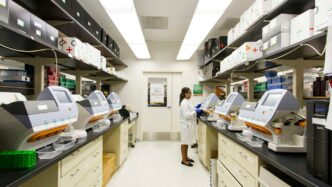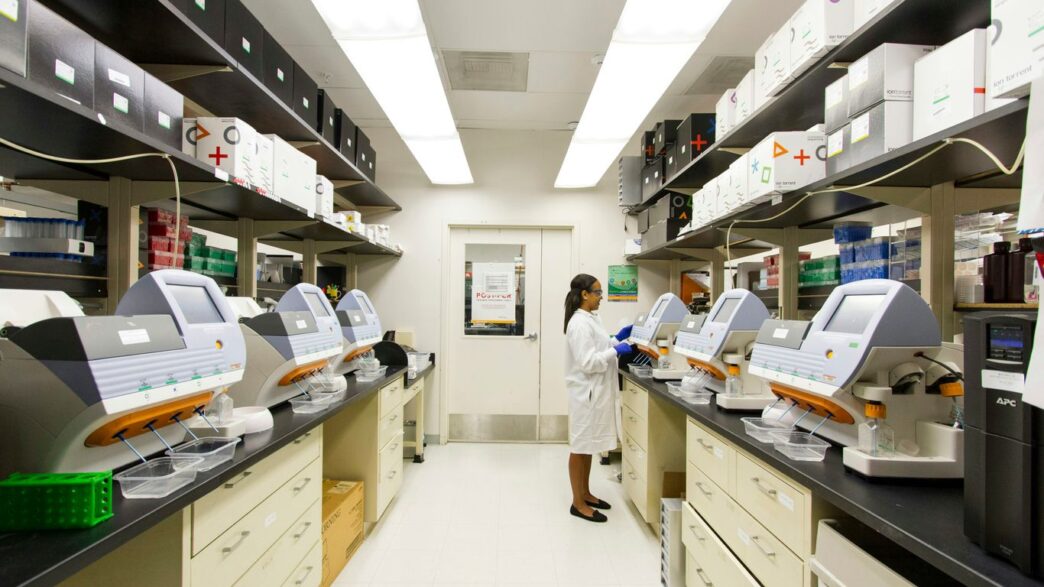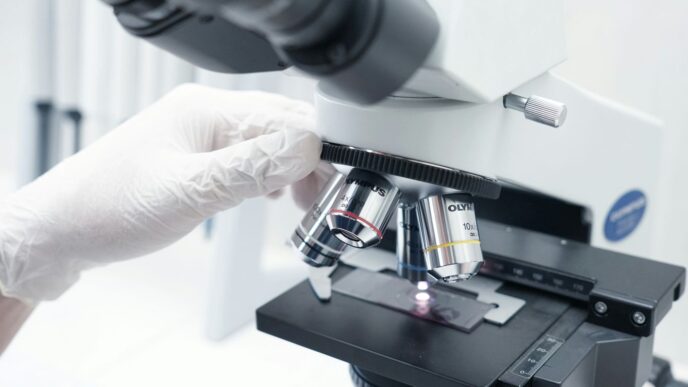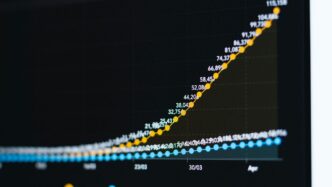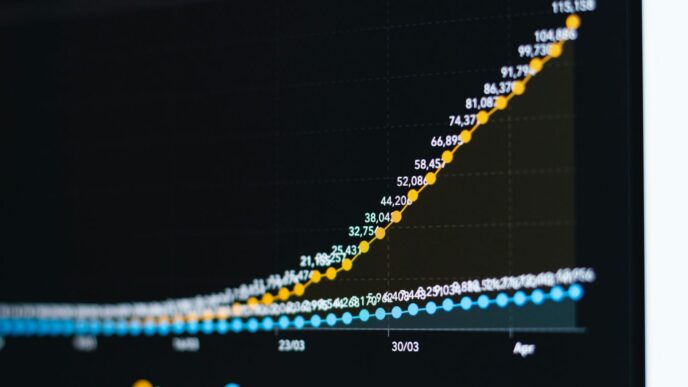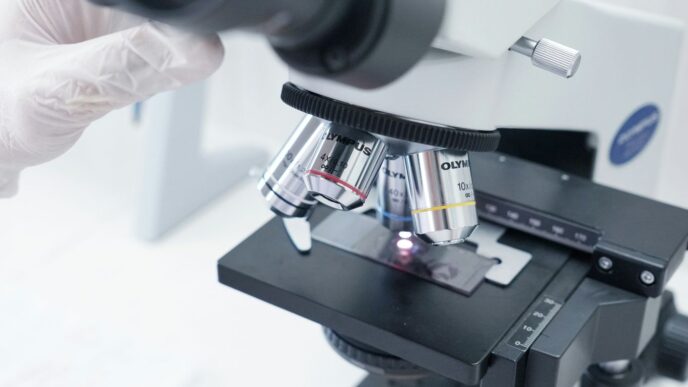The world of genetics is moving fast, and keeping up with the latest tools can feel like a challenge. One of the big players making waves is the MGI sequencer, known for its MGI Sequencer Capabilities that are changing how we look at DNA. From farming to figuring out diseases, this technology is opening up new possibilities. Let’s take a closer look at what makes the MGI sequencer so special and how it’s being used.
Key Takeaways
- The MGI sequencer, developed by MGI Tech, represents a significant step forward in high-throughput genetic analysis, integrating technologies like Complete Genomics to boost its capabilities.
- In agriculture, the BGI sequencer is proving useful for understanding livestock genetics, improving crops, and supporting the seed industry by providing detailed genetic information.
- This technology helps reduce reliance on other companies for sequencing, expands manufacturing globally, and makes high-volume genetic analysis more affordable.
- The market for genetic sequencing is dominated by Next-Generation Sequencing (NGS) technology, with strong growth in software for data analysis and a large share for consumables.
- BGI sequencers are paired with data analysis tools that simplify complex genetic information, especially for areas like molecular breeding, and offer cost-effective ways to prepare samples for sequencing.
Advancements in MGI Sequencer Technology

It’s pretty wild how fast sequencing tech has moved, right? MGI Tech has been a big player in this field. They’ve really pushed the boundaries on high-throughput sequencing, meaning they can churn out a ton of genetic data much faster than before. A big part of this push came from their integration of Complete Genomics technology. Remember them? They were acquired by MGI Tech a while back, and it really boosted MGI’S own sequencing capabilities. This acquisition was a game-changer, allowing MGI Tech to develop its own independent sequencing platforms and reduce reliance on other companies.
They haven’t just been working in a vacuum, though. BGI has been busy forming strategic partnerships. Think about their collaboration with Higentic, for instance. This partnership is all about using sequencing to boost China’s seed industry. It’s a pretty smart move, using their tech to help improve crops. They’ve also been working with US companies, which is interesting given the global tech landscape. These collaborations aren’t just for show; they’re about pooling resources and knowledge to create even better sequencing tools and applications. It’s like they’re building a whole ecosystem around their sequencers, making sure they’re not just powerful machines but also part of a larger network of innovation.
Applications of the MGI Sequencer in Agriculture
The MGI sequencer is really shaking things up in the agriculture world. It’s not just about sequencing DNA anymore; it’s about using that information to make better crops and livestock. Think about it – we can now look at the genetic makeup of animals and plants in ways we never could before. This technology is helping farmers and researchers figure out the best ways to breed animals and grow crops that are more resilient, productive, and nutritious. It’s a pretty big deal for food security and for making farming more sustainable.
Deciphering Genetic Architecture in Livestock
When it comes to livestock, understanding the genetics behind traits like disease resistance, growth rate, and meat quality is super important. The MGI sequencer allows scientists to get a really detailed look at the DNA of different animal breeds. This helps pinpoint specific genes that influence these desirable traits. By knowing which genes are responsible, breeders can make more informed decisions, leading to healthier and more productive herds. It’s like having a genetic roadmap for animal improvement. We can move beyond just guessing and start making targeted genetic selections.
Improving Crop Traits and Yield
For crops, the impact is just as significant. Researchers are using the MGI sequencer to understand the genetic basis of things like drought tolerance, pest resistance, and how much a plant can produce. This means we can develop new crop varieties that can withstand tougher environmental conditions and produce more food. For example, scientists can identify genes that help a plant survive with less water or resist common diseases. This is a huge step forward in ensuring we can feed a growing global population, especially with climate change making farming more challenging.
Here’s a look at some key areas:
- Disease Resistance: Identifying genetic markers associated with immunity to common crop diseases.
- Yield Enhancement: Pinpointing genes that contribute to higher grain or fruit production.
- Environmental Tolerance: Discovering genetic traits that allow crops to thrive in challenging conditions like drought or salinity.
- Nutritional Value: Selecting for varieties with improved vitamin or mineral content.
Supporting Seed Industry Revitalization
The seed industry is the foundation of agriculture, and the MGI sequencer is playing a role in its modernization. By enabling low-cost, high-throughput sequencing, it provides the tools needed for advanced breeding programs. This means faster development of improved seed varieties. It’s helping to create a more robust and innovative seed sector, which in turn benefits farmers and the entire food supply chain. This technology is a key part of national plans aimed at strengthening agricultural self-sufficiency and competitiveness through advanced biotechnology.
MGI Sequencer’s Impact on Research and Development
The MGI sequencer has really changed the game for research and development, especially by giving scientists more options and making things more affordable. It’s like having a new tool that lets you do more without relying on just a few big players.
Reducing Dependence on Competitors
Before, a lot of research labs were pretty much stuck using sequencers from a couple of major companies. This meant they had to go with whatever those companies offered, and sometimes, the costs were pretty high. MGI Tech’s technology has provided a real alternative. They’ve developed their own sequencing platforms, like the DNBSEQ series, which offer competitive performance. This has helped reduce the reliance on any single provider, giving researchers more flexibility and potentially better pricing. It’s a big deal because it means more labs can access advanced sequencing without being locked into one system. This shift is helping to democratize access to cutting-edge genomic tools.
Expanding Global Manufacturing Footprint
MGI isn’t just keeping its technology to itself. They’ve been actively expanding their manufacturing capabilities globally. For instance, Complete Genomics, a subsidiary of MGI Tech, has been building new manufacturing facilities, like the one in San Jose, California. This isn’t just about making more machines; it’s about having production closer to researchers in different regions. Having these overseas bases means quicker access to products and support, which is super helpful for ongoing research projects. It also shows a commitment to being a global player in the sequencing market, not just a regional one.
Enabling Low-Cost, High-Throughput Sequencing
One of the most significant impacts is how MGI sequencers make high-throughput sequencing more accessible financially. They’ve partnered with companies like Gencove and seqWell to offer bundled solutions. These collaborations focus on streamlining processes, like library preparation, and offering low-pass whole genome sequencing (LP-WGS). The goal is to get high-quality results at a lower cost. This is huge for fields like agriculture, where researchers are trying to decipher complex genetic traits in crops and livestock. Being able to sequence more samples for less money means more data can be generated, leading to faster discoveries and improvements in areas like crop yield and disease resistance. It really opens up possibilities for projects that might have been too expensive before.
Next-Generation Sequencing Market Dynamics
The world of genetic sequencing is really taking off, and it’s not hard to see why. We’re talking about a market that’s projected to jump from about $22.63 billion in 2024 to a whopping $101.93 billion by 2034. That’s a massive growth spurt, with a compound annual growth rate of around 16.24% between 2025 and 2034. It seems like everyone’s getting on board with sequencing for everything from understanding diseases to developing new treatments.
Dominance of Next-Generation Sequencing Technology
When you look at the tech itself, Next-Generation Sequencing (NGS) is the big player right now. It’s the method that lets us look at millions of DNA bits all at once, giving us a really detailed picture of genetic variations and how genes are working. The constant push to make NGS faster, cheaper, and more accurate is what’s really driving its lead. This technology is opening up new doors for understanding illnesses and even tailoring treatments to individuals.
Growth in Software and Data Analysis
But here’s the thing: all that sequencing generates a ton of data. Like, a lot. So, it’s no surprise that the software side of things is growing rapidly. We need smart tools to sort through all that biological information, figure out what it means, and make sense of it. Bioinformatics software and web-based tools are becoming super important for researchers to explore, search, and study all this genomic data. It’s the engine that turns raw sequences into useful knowledge.
Consumables Segment’s Significant Share
And then there are the consumables – the reagents, the kits, all the stuff you need to actually do the sequencing. This part of the market is also huge. Because we’re doing so much sequencing, and because the methods for things like target enrichment are always getting better, the demand for these supplies keeps climbing. Companies are working hard to improve their consumable products, which just adds to this segment’s big slice of the pie. It’s a bit like the razor and blades model, really.
Here’s a quick look at how things are shaping up:
| Segment | Status in 2024 | Projected Growth Driver |
|---|---|---|
| Next-Generation Sequencing (Technology) | Dominant | Improved accuracy, speed, and cost-effectiveness |
| Software | Fastest Growing | Need for complex data analysis and interpretation |
| Consumables | Major Share | Frequent use, ongoing improvements, clinical applications |
MGI Sequencer and Data Analysis Pipelines
When you’re working with the MGI sequencer, getting the data out is just the first step. What you do with that data is where the real science happens. MGI and its partners are putting a lot of effort into making sure the analysis part is as smooth as the sequencing itself. They’re not just about building the machines; they’re building the whole system around them.
Streamlined Solutions for Molecular Breeding
For folks working in molecular breeding, especially in agriculture, speed and cost are big deals. MGI’s tech, through collaborations like the one with Gencove, is aiming to make low-pass whole genome sequencing more accessible. This means researchers can get results faster and cheaper, which is a huge help when you’re trying to find those specific genetic markers that can improve crops or livestock. Think about it: instead of waiting months and spending a fortune, you can get insights that help speed up the development of better seeds or more productive animals. This accessibility is changing how quickly we can make genetic improvements.
Tools for Analyzing Complex Genomic Data
Genomic data can get pretty messy, pretty fast. MGI’s approach includes developing or partnering on tools that can handle this complexity. They’re looking at ways to make sense of large datasets, whether it’s for understanding the genetic makeup of livestock or figuring out the best traits for new crop varieties. It’s not just about raw data; it’s about turning that data into actionable information. This involves software and platforms that can process and interpret the results from the sequencers, making the findings easier to understand and use.
Cost-Effective Library Preparation Methods
Before you can even sequence DNA, you have to prepare your samples, and that’s called library preparation. This step can be a bottleneck, both in terms of time and money. MGI is working with companies like seqWell, who specialize in making this process cheaper and more efficient. When library prep is more affordable, it opens up sequencing to more projects and more researchers. It’s another piece of the puzzle that makes high-throughput sequencing more practical for a wider range of applications, from agricultural research to other scientific fields.
Wrapping It Up
So, we’ve taken a good look at what MGI’s sequencers can do. It’s pretty clear these machines are powerful tools, helping scientists figure out all sorts of genetic information. From understanding crops to looking at animal traits, the technology is making a real difference. It’s not just about the hardware, though; the way the data is handled and used is just as important. As this field keeps moving forward, it’s exciting to think about what new discoveries MGI’s sequencers will help us make. It really shows how far genetic research has come and where it might be heading next.
Frequently Asked Questions
What makes the MGI Sequencer special compared to other machines?
The MGI Sequencer is known for being very fast and able to process a lot of genetic information at once. It also uses unique methods, like those from Complete Genomics, which helps MGI create its own advanced technology without relying too much on other companies.
How is the MGI Sequencer used in farming?
In farming, this technology helps scientists understand the genes of animals like pigs to make them healthier and grow better. For crops, it helps find ways to make plants stronger, grow more food, and improve the quality of seeds. It’s a big help for making farming better.
Does MGI Sequencer help other scientists with their work?
Yes, by making its own sequencing machines, MGI Tech helps reduce the need to buy expensive equipment from other countries. This makes advanced genetic testing more affordable and available, allowing more research and development to happen, even in new places around the world..
What’s the deal with ‘Next-Generation Sequencing’?
Next-Generation Sequencing, or NGS, is the main type of technology used today for reading DNA. It’s like a super-fast way to look at all the genetic information. Because it’s so important, there’s a big market for the machines, the special chemicals (consumables) used with them, and the computer programs needed to understand all the data.
How does the MGI Sequencer handle all the genetic data?
MGI offers special computer programs and methods to make sense of the huge amounts of genetic information collected by their sequencers. These tools help with things like improving crops and make the whole process of preparing the genetic samples and analyzing the data much easier and cheaper..
Are there different parts to the DNA sequencing business?
Yes, just like in other tech industries, DNA sequencing has different parts. There’s the hardware (the machines themselves), the software (for analyzing data), and the consumables (like special liquids and tools used during the process). Each part is important for the whole system to work.

